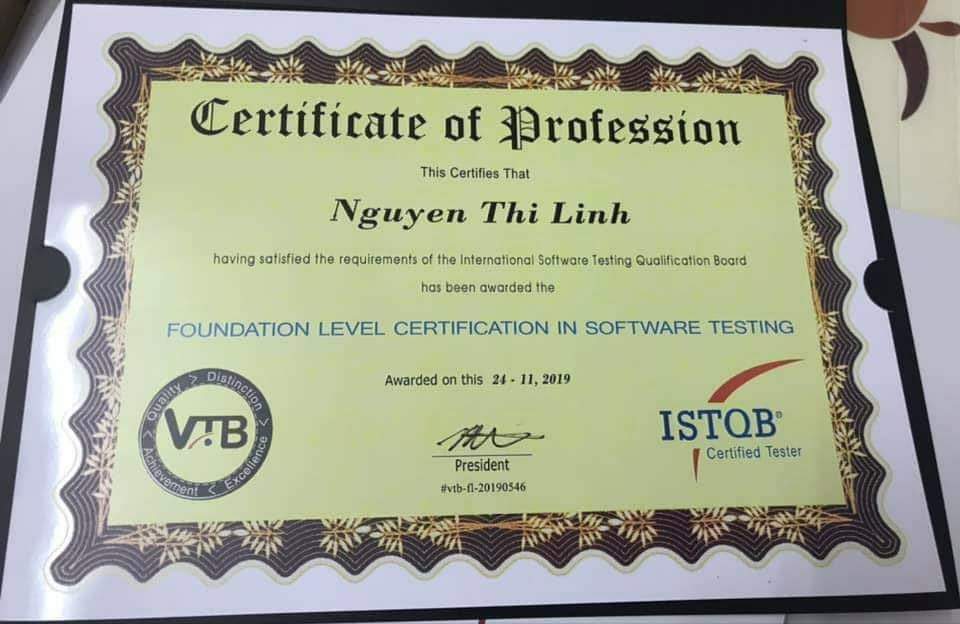Nội dung Khóa học Ôn thi chứng chỉ Test Quốc Tế - ISTQB Foundation Level 4.0 gồm Khóa bao gồm 16.5 buổi ( 33 hour)
1. Fundamentals of Testing
1.1. What is Testing?
1.1.1. Test Objectives
1.1.2. Testing and Debugging
1.2. Why is Testing Necessary?
1.2.1. Testing’s Contributions to Success
1.2.2. Testing and Quality Assurance (QA)
1.2.3. Errors, Defects, Failures, and Root Causes
1.3. Testing Principles
1.4. Test Activities, Testware and Test Roles
1.4.1. Test Activities and Tasks
1.4.2. Test Process in Context
1.4.3. Testware
1.4.4. Traceability between the Test Basis and Testware
1.4.5. Roles in Testing
1.5. Essential Skills and Good Practices in Testing
1.5.1. Generic Skills Required for Testing
1.5.2. Whole Team Approach
1.5.3. Independence of Testing
2. Testing Throughout the Software Development Lifecycle
2.1. Testing in the Context of a Software Development Lifecycle
2.1.1. Impact of the Software Development Lifecycle on Testing
2.1.2. Software Development Lifecycle and Good Testing Practices
2.1.3. Testing as a Driver for Software Development
2.1.4. DevOps and Testing
2.1.5. Shift-Left Approach
2.1.6. Retrospectives and Process Improvement
2.2. Test Levels and Test Types
2.2.1. Test Levels
2.2.2. Test Types
2.2.3. Confirmation Testing and Regression
2.3. Maintenance Testing
3. Static Testing
3.1. Static Testing Basics
3.1.1. Work Products Examinable by Static Testing
3.1.2. Value of Static Testing
3.1.3. Differences between Static Testing and Dynamic Testing
3.2. Feedback and Review Process
3.2.1. Benefits of Early and Frequent Stakeholder Feedback
3.2.2. Review Process Activities
3.2.3. Roles and Responsibilities in Reviews
3.2.4. Review Types
3.2.5. Success Factors for Reviews
4. Test Analysis and Design
4.1. Test Techniques Overview
4.2. Black-Box Test Techniques
4.2.1. Equivalence Partitioning
4.2.2. Boundary Value Analysis
4.2.3. Decision Table Testing
4.2.4. State Transition Testing
4.3. White-Box Test Techniques
4.3.1. Statement Testing and Statement Coverage
4.3.2. Branch Testing and Branch Coverage
4.3.3. The Value of White-box Testing
4.4. Experience-based Test Techniques
4.4.1. Error Guessing
4.4.2. Exploratory Testing
4.4.3. Checklist-Based Testing
4.5. Collaboration-based Test Approaches
4.5.1. Collaborative User Story Writing
4.5.2. Acceptance Criteria
4.5.3. Acceptance Test-driven Development (ATDD)
5. Managing the Test Activities
5.1. Test Planning
5.1.1. Purpose and Content of a Test Plan
5.1.2. Tester’s Contribution to Iteration and Release Planning
5.1.3. Entry Criteria and Exit Criteria
5.1.4. Estimation Techniques
5.1.5. Test Case Prioritization
5.1.6. Test Pyramid
5.1.7. Testing Quadrants
5.2. Risk Management
5.2.1. Risk Definition and Risk Attributes
5.2.2. Project Risks and Product Risks
5.2.3. Product Risk Analysis
5.2.4. Product Risk Control
5.3. Test Monitoring, Test Control and Test Completion
5.3.1. Metrics used in Testing
5.3.2. Purpose, Content and Audience for Test Reports
5.3.3. Communicating the Status of Testing
5.4. Configuration Management
5.5. Defect Management
6. Test Tools
6.1. Tool Support for Testing
6.2. Benefits and Risks of Test Automation
Điểm Thi Chứng chỉ Test Quốc Tế ISTQB Foundation level của Học viên TesterTOP
Làm Đúng 39/40 câu

Chứng chỉ Test Quốc Tế ISTQB Foundation level của Học viên TesterTOP

Tài liệu học và Quiz ôn thi ISTQB tham khảo:
- Syllabus tài liệu chính: https://istqb-main-web-prod.s3.amazonaws.com/media/documents/ISTQB_CTFL_Syllabus-v4.0.pdf
- Syllabus trình bày tóm tắt khó đọc, quyển 200 trang (bộ cũ) diễn giải chi tiết istqb_material
- Glossary các khái niệm, định nghĩa và thuật ngữ https://glossary.istqb.org/en_US/search?term=&exact_matches_first=true
- Đề thi thử: Bạn download đề thi thử và đáp án để tự review trước khi thi ở đây nhé
5. Đăng ký thi thử online: https://certificate.isqi.org/online-mock-exams-ctfl-4.0
6. Tra cứu thông tin chứng chỉ của bạn: http://scr.istqb.org/
Hình ảnh Lớp học TesterTOP
.jpg)